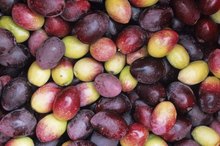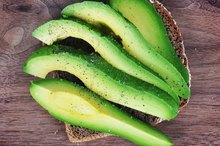What does fact checked mean?
At Healthfully, we strive to deliver objective content that is accurate and up-to-date. Our team periodically reviews articles in order to ensure content quality. The sources cited below consist of evidence from peer-reviewed journals, prominent medical organizations, academic associations, and government data.
- Office of Dietary Supplements Dietary Supplement Fact Sheet: Iron
- Linus Pauling Institute Micronutrient Information Center: Vitamin A
- Linus Pauling Institute Micronutrient Information Center: Vitamin C
- Office of Dietary Supplements Dietary Supplement Fact Sheet: Calcium
The information contained on this site is for informational purposes only, and should not be used as a substitute for the advice of a professional health care provider. Please check with the appropriate physician regarding health questions and concerns. Although we strive to deliver accurate and up-to-date information, no guarantee to that effect is made.
The Vitamins & Minerals Found in Capsicum
Capsicum is a flowering plant in the nightshade family that bears the fruit that most of us know as peppers or chiles. The taste of peppers ranges from the mild and sweet to the painfully hot. The 27 species of capsicum also vary as to their vitamin and mineral content.
Vitamins and Minerals in Different Capsicum Varieties
Capsicum is generally a source of vitamin A and C, but the values of these vitamins vary significantly according to the type of pepper. The amounts of dietary minerals in peppers are not as variable between types. One cup of chopped sweet raw red peppers provides 93 percent of the average daily value for vitamin A and 317 percent of the average daily value for vitamin C. They contain 1 percent of the average daily value for calcium and 4 percent for iron. The same amount of chopped sweet raw green peppers is somewhat less nutritious, with a daily value of 11 percent for vitamin A , 200 percent for vitamin C, 1 percent for calcium and 3 percent for iron. One cup of raw jalapenos contains 14 percent for of the daily value for vitamin A , 66 vitamin C, 1 percent for calcium and 4 percent for iron.
- Capsicum is generally a source of vitamin A and C, but the values of these vitamins vary significantly according to the type of pepper.
- The same amount of chopped sweet raw green peppers is somewhat less nutritious, with a daily value of 11 percent for vitamin A , 200 percent for vitamin C, 1 percent for calcium and 3 percent for iron.
Vitamin A
Green Chile Nutrition
Learn More
According to the Linus Pauling Micronutrient Information Center, vitamin A's nickname is the "anti-infective vitamin" because of its critical role in maintaining the immune system 23. Vitamin A is also a key nutrient for the eyes. If you do not get enough vitamin A, you may develop a condition called "night blindness" in which your ability to see in dim light is compromised. Vitamin A is also important for red blood cell production and normal fetal development.
- According to the Linus Pauling Micronutrient Information Center, vitamin A's nickname is the "anti-infective vitamin" because of its critical role in maintaining the immune system 2.
- Vitamin A is also important for red blood cell production and normal fetal development.
Vitamin C
The fruits of most capsicum species, especially the red varieties, are especially rich sources of vitamin C. Vitamin C, according to the Linus Pauling Center, plays a vital role in the synthesis of collagen, a major structural protein in the body 23. Vitamin C is also a robust antioxidant that helps protect your cells from being damaged by the harmful free radicals that have been implicated in chronic disease and aging.
Calcium
What Vitamins Are in Lettuce?
Learn More
You will need more sources of calcium than capsicum, although peppers do provide a small proportion of the average daily requirement. Calcium, according to the Office of Dietary Supplements at the National Institutes of Health, is so vital to physiological functioning that the body will take the calcium that it needs from the bones if insufficient amounts are obtained through dietary sources 14. Post-menopausal women are at special risk for calcium deficiencies, which can lead to weakened bones and fractures.
Iron
Iron deficiencies are among the top nutritional disorders worldwide, according to the Office of Dietary Supplements 14. Women of childbearing age and young children comprise the population that is most at risk. Iron is necessary to bring oxygen to the tissues in your body. Insufficient iron in your diet can lead to fatigue and impaired immunity. Use other food sources of iron besides capsicum to guarantee that you get enough.
- Iron deficiencies are among the top nutritional disorders worldwide, according to the Office of Dietary Supplements 1.
- Use other food sources of iron besides capsicum to guarantee that you get enough.
Related Articles
References
- Office of Dietary Supplements Dietary Supplement Fact Sheet: Iron
- Linus Pauling Institute Micronutrient Information Center: Vitamin A
- Linus Pauling Institute Micronutrient Information Center: Vitamin C
- Office of Dietary Supplements Dietary Supplement Fact Sheet: Calcium
- USDA National Nutrient Database
- Holick MF, Gordon CM. Patient Guide to Vitamin D Deficiency. The Journal of Clinical Endocrinology & Metabolism. 2011;96(7):1-2. doi:10.1210/jcem.96.7.zeg33a
- Sunyecz JA. The use of calcium and vitamin D in the management of osteoporosis. Ther Clin Risk Manag. 2008;4(4):827-836. doi:10.2147/tcrm.s3552
- Giovannucci E, Liu Y, Hollis BW, Rimm EB. 25-hydroxyvitamin D and risk of myocardial infarction in men: a prospective study. Arch Intern Med. 2008;168(11):1174-1180. doi:10.1001/archinte.168.11.1174
- Gorham ED, Garland CF, Garland FC, et al. Optimal vitamin D status for colorectal cancer prevention: a quantitative meta analysis. Am J Prev Med. 2007;32(3):210-216. doi:10.1016/j.amepre.2006.11.004
- Lappe JM, Travers-Gustafson D, Davies KM, Recker RR, Heaney RP. Vitamin D and calcium supplementation reduces cancer risk: results of a randomized trial. The American Journal of Clinical Nutrition. 2007;85(6):1586-1591. doi:10.1093/ajcn/85.6.1586
- Prentice RL, Pettinger MB, Jackson RD, et al. Health risks and benefits from calcium and vitamin D supplementation: Women’s Health Initiative clinical trial and cohort study. Osteoporos Int. 2013;24(2):567-580. doi:10.1007/s00198-012-2224-2
- Urashima M, Segawa T, Okazaki M, Kurihara M, Wada Y, Ida H. Randomized trial of vitamin D supplementation to prevent seasonal influenza A in schoolchildren. Am J Clin Nutr. 2010;91(5):1255-1260. doi:10.3945/ajcn.2009.29094
- Salehpour A, Hosseinpanah F, Shidfar F, et al. A 12-week double-blind randomized clinical trial of vitamin D₃ supplementation on body fat mass in healthy overweight and obese women. Nutr J. 2012;11:78. doi:10.1186/1475-2891-11-78
- Carrillo AE, Flynn MG, Pinkston C, et al. Impact of vitamin D supplementation during a resistance training intervention on body composition, muscle function, and glucose tolerance in overweight and obese adults. Clin Nutr. 2013;32(3):375-381. doi:10.1016/j.clnu.2012.08.014
- Marcinowska-Suchowierska E, Kupisz-Urbańska M, Łukaszkiewicz J, Płudowski P, Jones G. Vitamin D Toxicity-A Clinical Perspective. Front Endocrinol. 2018;9:550. doi:10.3389/fendo.2018.00550
- Ross AC, Manson JE, Abrams SA, et al. The 2011 report on dietary reference intakes for calcium and vitamin D from the Institute of Medicine: what clinicians need to know. J Clin Endocrinol Metab. 2011;96(1):53-58. doi:10.1210/jc.2010-2704
- Bouillon R, Van Schoor NM, Gielen E, et al. Optimal vitamin D status: a critical analysis on the basis of evidence-based medicine. J Clin Endocrinol Metab. 2013;98(8):E1283-E1304. doi:10.1210/jc.2013-1195
- American Academy of Dermatology. Position Statement of Vitamin D. 2010.
- Taksler GB, Cutler DM, Giovannucci E, Keating NL. Vitamin D deficiency in minority populations. Public Health Nutr. 2015;18(3):379-391. doi:10.1017/S1368980014000457
- Holick MF, Binkley NC, Bischoff-Ferrari HA, et al. Evaluation, treatment, and prevention of vitamin D deficiency: an Endocrine Society clinical practice guideline. J Clin Endocrinol Metab. 2011;96(7):1911-1930. doi:10.1210/jc.2011-0385
- Cannell JJ, Vieth R, Umhau JC, et al. Epidemic Influenza and Vitamin D. Epidemiol Infect. 2006; 134:1129-40.
- Carrillo AE1, Flynn MG, Pinkston C, Markofski MM, Jiang Y, Donkin SS, Teegarden D. Impact of Vitamin D Supplementation During a Resistance Training Intervention on Body Composition, Muscle Function, and Glucose Tolerance in Overweight and Obese Adults. Clin Nutr. 2013 Jun;32(3):375-81. doi: 10.1016/j.clnu.2012.08.014. Epub 2012 Aug 31.
- Ginde AA, Mansbach JM, Camargo CA, Jr. Association Between Serum 25-Hydroxyvitamin D Level and Upper Respiratory Tract Infection in the Third National Health and Nutrition Examination Survey. Arch Intern Med. 2009; 169:384-90.
- Giovannucci E, Liu Y, Hollis BW, Rimm EB. 25-hydroxyvitamin D and Risk of Myocardial Infarction in Men: a Prospective Study. Arch Intern Med. 2008; 168:1174-80.
- Gorham ED, Garland CF, Garland FC, Grant WB, Mohr SB, Lipkin M, Newmark HL, Giovannucci E, Wei M, Holick MF. Optimal Vitamin D Status for Colorectal Cancer Prevention: a Quantitative Meta-analysis. Am J Prev Med. 2007 Mar;32(3):210-6.
- Heaney, Robert P. “The Vitamin D Requirement in Health and Disease.” The Journal of Steroid Biochemistry & Molecular Biology 97 (2005):13-9.
- Holick MF. Vitamin D. In: Shils M, Olson J, Shike M, Ross AC, ed. Modern Nutrition in Health and Disease, 9th ed. Baltimore: Williams and Wilkins, 1999.
- National Institutes of Health Office of Dietary Supplements. Vitamin D: Dietary Supplement Fact Sheet. University of Ottawa Evidence-based Practice Center. Effectiveness and Safety of Vitamin D in Relation to Bone Health. Agency for Healthcare Research and Quality. Aug 2007: 07-E013.
- Salehpour A1, Hosseinpanah F, Shidfar F, Vafa M, Razaghi M, Dehghani S, Hoshiarrad A, Gohari M. A 12-week Double-blind Randomized Clinical Trial of Vitamin D₃ Supplementation on Body Fat Mass in Healthy Overweight and Obese Women. Nutr J. 2012 Sep 22;11:78. doi: 10.1186/1475-2891-11-78.
- Urashima M, Segawa T, Okazaki M, Kurihara M, Wada Y, Ida H. Randomized Trial of Vitamin D Supplementation to Prevent Seasonal Influenza A in Schoolchildren. Am J Clin Nutr. 2010 91:1255-60. Epub 2010 Mar 10.
- Wilkins, Consuelo H. and Yvette I. Sheline, et al. “Vitamin D Deficiency Is Associated with Low Mood and Worse Cognitive Performance in Older Adults.” American Journal of Geriatric Psychiatry 14 (2006): 1032-40.
Writer Bio
Cindy Ell began writing professionally in 1990. A former medical librarian, she has written materials for hospitals, medical associations, the "Nashville Scene" and "Coping Magazine." She received her Bachelor of Arts in linguistics from the University of Massachusetts and her Master of Library and Information Science from Pratt Institute. She is currently a full-time freelance medical writer.









